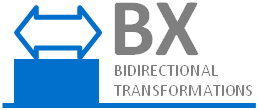|
First International Workshop on Bidirectional Transformations (BX 2012) Sun, March 25, 2012 Tallinn, Estonia co-located with ETAPS 2012 http://www.program-transformation.org/BX12 |
 | @ |

|
|---|
Aims and Topics
The aim of the workshop is to bring together researchers, established and new, interested in bidirectional transformations from different perspectives, such as: language-based approaches, software/model transformations, and data/schema co-evolution. Topics of interest for BX'12 include, but are not limited to:- (coupled) software/model transformations
- software-model synchronization
- data-schema co-evolution and data synchronization
- consistency analysis
- language-based approaches
- analysis/classification of requirements for bx technologies
- case studies and tool support
- comparison of bx technologies
- efficiency of algorithms and benchmarks
- research papers providing new concepts and results
- position papers and research perspectives
- papers that apply bx in new domains
- papers closing gaps between formal concepts and application scenarios
Proceedings
Accepted regular papers will appear as a volume of EC-EASST. A preliminary version of the proceedings, including the short papers and lightning talk abstracts as well, will be available at the workshop. Authors of short papers may be invited to extend their contribution to a full paper for inclusion in the formal proceedings. Submissions can use LNCS or EC-EASST style. See the submission guidelines for details. Follow this link for the complete Call for Papers. There is also a more compact PDF version.| I | Attachment  | Action | Size | Date | Who | Comment |
|---|---|---|---|---|---|---|
| | BX12_cfp.pdf | manage | 370.4 K | 29 Oct 2011 - 06:54 | JanisVoigtlaender |